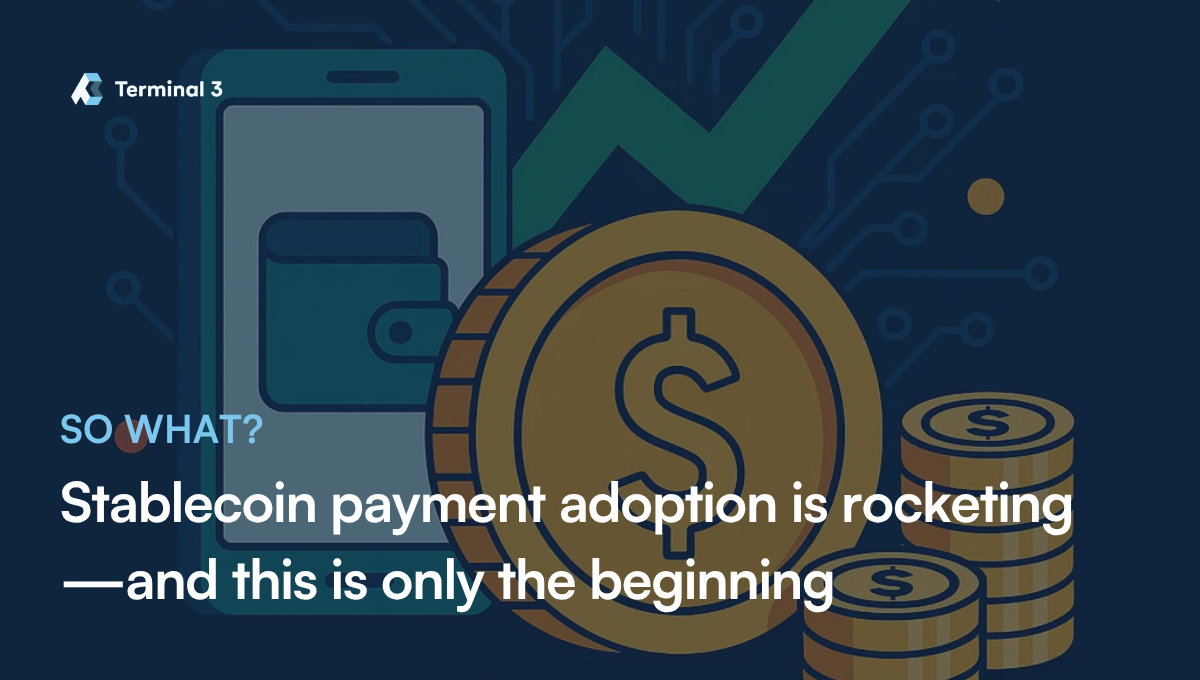Stablecoin payment adoption is rocketing— and this is only the beginning

GM,
Shopify, Stripe, PayPal, Visa, Uber, Apple, Google… these are some of the companies that have integrated or are considering integrating stablecoins into their business.
We wrote about the potential of stablecoins nearly 18 months ago, but the concept of digital money has rapidly gained traction even over that short period. It’s now possible to live entirely from stablecoins on a daily basis.
What better time to do so now that major companies are diving in?
Best,
What’s going on?
Stablecoins are having a moment.
There’s never been such attention thrust on them. We know payment aggregators have embraced stablecoins: PayPal has its own, and Stripe spent more than $1 billion when it acquired stablecoin platform Bridge.
Now, companies themselves are stepping forward.
Shopify just announced plans to allow its merchants to accept stablecoins, in partnership with Stripe—while Stripe itself acquired crypto wallet provider Privy.
And it isn’t just the payment providers. Uber CEO Dara Khosrowshahi said publicly this month that the ride-hailing firm is investigating how it could use stablecoins to move money around its international business.
Uber is likely one of many tech giants conducting research. A recent Fortune report claimed Apple, Google, X and Airbnb are among others investigating the feasibility of integrating stablecoins.
These aren’t isolated, data from a Coinbase survey shows. The crypto exchange found that nearly one in five executives at Fortune 500 companies are making plans that include an on-chain strategy—with 29% explicitly saying stablecoins will be part of their company’s future. That’s up from 8% one year ago.
What is it that’s getting everyone so interested?

SO WHAT?
1. Bridging the gaps
Stablecoins are gaining momentum because they make it easier for sellers to accept money from any customer in the world.
They’re not replacing currencies like the US Dollar, Euro, British Pound or Japanese Yen. Instead, they provide a universal currency that’s particularly useful in countries with less liquid currencies.
“By embracing stablecoins, merchants aren’t just adopting a new payment method, they’re tapping into global markets, opening the door to global customers, and joining the future of borderless, accessible commerce,” wrote Shopify in its announcement.
“Small businesses should be able to sell to a customer on the other side of the world as easily as their next-door neighbor,” it added.
The company will initially accept Circle’s USDC stablecoin on Base—the Coinbase-operated blockchain that we’ve written about extensively—but you’d imagine there are plans to broaden the options. Shopify isn’t new to crypto payments—Bitcoin has been available as a payment option for more than a decade.
Stripe allows its merchants to receive stablecoins across four different blockchains, although all payments are settled in US Dollars. That means that, for now, stablecoins are just another currency to enable merchants to reach more customers. It also makes sense because it avoids regulatory uncertainty as many countries, including the US, are still finalizing laws around stablecoins.
Shopify, however, has added an option for merchants to keep their stablecoin payments in a crypto wallet, which is where things can start to get interesting.
2. Digital money means digital banking
Merchants holding stablecoin on their balance sheet, as they can if they are a Shopify customer, potentially unlocks a range of new options further down the line.
In the immediate term, it would allow them to generate yield on their stablecoin balance if they use a DeFi service or other treasury management options. Depending on the appetite for risk, rates can exceed bank interest and APY (Annual Percentage Yield) can potentially reach double-digits.
Those that want to be more adventurous could invest directly in cryptocurrencies. That’s not as crazy as it once might have sounded given that there are numerous listed companies, countries and US states with strategic crypto reserves.
After that, we can start to speculate and future-gaze based on trends that are gathering speed.
The last couple of years have seen an acceleration in the idea of Central Bank Digital Currencies (CBDCs) and appetite for company stablecoins is growing, too. Companies including M0 allow businesses to mint and manage their own stablecoins.
Uber, for example, could create ‘Uber Coin’—or UberUSD—which could add a whole new dimension to its user experience.
- Customers could earn yield for keeping a balance in their Uber account
- Uber could provide incentives through its coin—saving its balance sheet
- Uber could make money from transaction fees on its coin
With stablecoins on its balance sheet, Uber could generate yield by carefully managing its treasury using DeFi strategies and other Web3-centric strategies.

We haven’t seen a deluge of company-issued stablecoins yet, but we’d expect to see some high-profile examples arrive before the end of this year. Particularly given an increase in stablecoin acceptance from payment platforms.
3. Digital futures
The initial use case is likely to be behind the scenes, reducing the cost of moving money around the world—particularly in ‘exotic’ markets where the local currency is less traded.
In that respect, stablecoins have already impacted the global financial plumbing without necessarily changing the end-user experience. But there’s potential to change as digital money becomes a more mainstream phenomenon.
Right now, off- and on-ramping charges mean that stablecoins are still not an effective way of handling liquid currencies such as those of G10 nations, as Jack Zhang—the founder of global banking platform Airwallex—pointed out in a LinkedIn post that attracted plenty of attention.

But things get interesting when there’s no need to off-ramp.
For example when a merchant selling a product using Shopify is able to use the USDC that it receives from customers to pay salaries, buy raw materials or cover its marketing agency costs. In such a situation, banks, credit card companies and other financial institutions are disintermediated.
The above already happens with many Web3 startups, but regulatory uncertainty prevents larger companies from taking the plunge. Plus, in first-world countries or for domestic-only companies, the current banking system suffices.
It’s no wonder, then, that the likes of Stripe, Shopify, Visa, Mastercard, PayPal and others have jumped in to integrate stablecoin payments into their existing products. They need to. If they don’t, they could become irrelevant.
News bytes
Circle’s share price is flying after it went public earlier this month—the clues are in this newsletter, dear reader
Vietnam will introduce a framework for managing digital assets from January 1 2026
Stripe acquired Privy, which develops API for wallets and other on-chain transactions
Memecoin platform Pump.fun and a number of other Web3 projects had their X accounts abruptly suspended—it’s not clear why, but the moves will make it challenging to communicate directly with their users and the wider industry
Crypto exchange ByBit launched its first decentralized exchange (DEX), which is based on the Solana chain
That’s all for this week!
Share your feedback, questions or requests via email to: sowhat@terminal3.io





